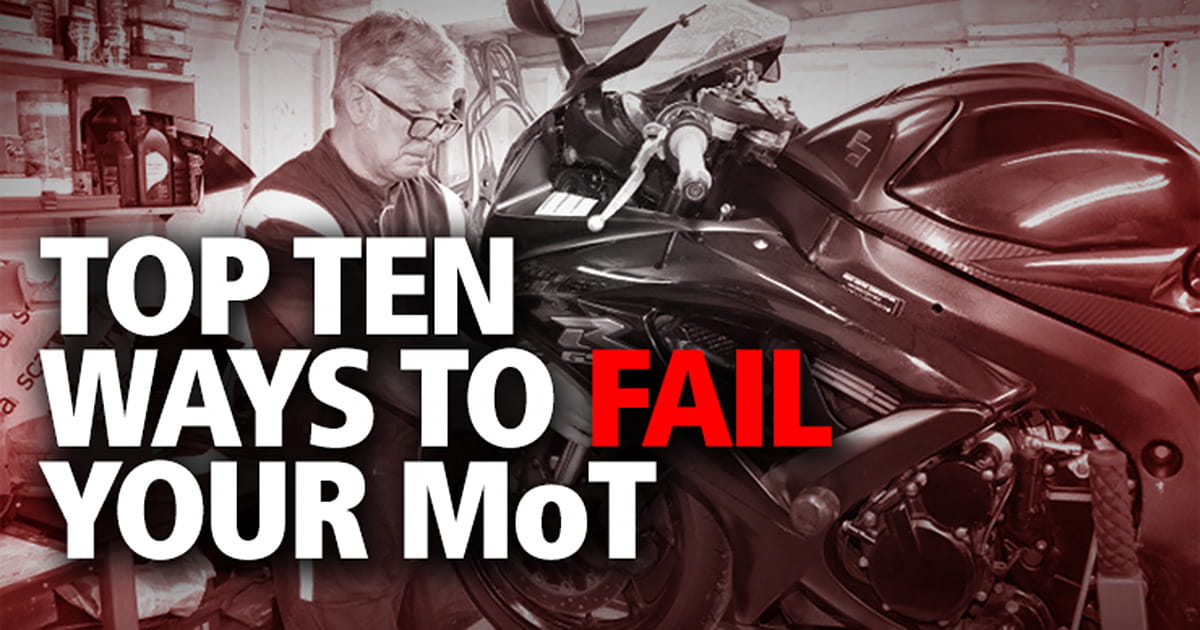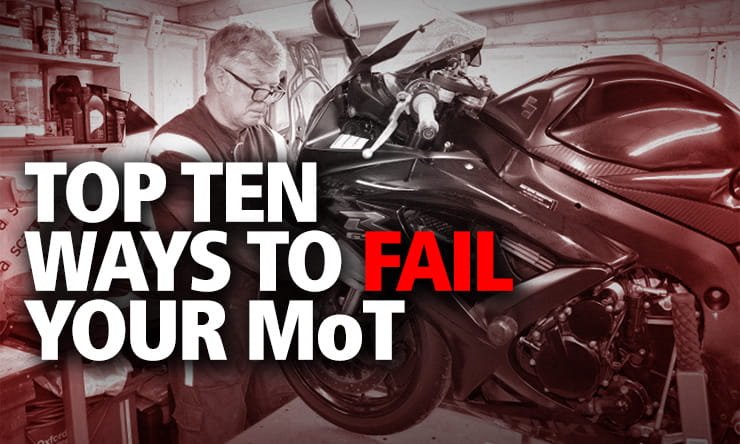A motorcycle can fail its MOT due to issues with brakes, tires, or lights. Faulty exhaust systems or suspension problems can also lead to failure.
Securing a passing grade on the Motorcycle MOT (Ministry of Transport) test is a critical step for any bike owner in the UK. This annual assessment ensures that motorcycles over three years old meet legal safety and environmental standards. Riding on the edge of innovation and regulation, your motorcycle must showcase optimal performance in various areas, from the efficiency of the braking system to the robust condition of the tires.
The MOT scrutinizes the functionality and condition of lights, signaling devices, and the structure of the bike itself, ensuring everything operates as it should. Emissions are under the spotlight too, as the exhaust system must not only be secure but also compliant with emission regulations. A failure in any of these key areas can result in a failed MOT, necessitating repairs to keep your two-wheeled companion roadworthy and legally compliant.
Table of Contents
Introduction To The Mot Test For Motorcycles
Imagine a bike that runs smoothly and safely on roads. The MOT test ensures this. All motorcycles over three years old must pass the MOT test each year. This test checks if your motorcycle meets road safety and environmental standards. A certificate confirms the bike’s fitness on the road.
Purpose Of The Mot
The MOT test plays a crucial role in road safety. It aims to ensure that motorcycles remain safe to drive. This yearly check-up helps spot any issues that might compromise a rider’s safety. It also looks at emission levels, helping protect the environment.
General Criteria For Passing
The MOT test covers many bike areas. Each must be in good condition for a pass. Here’s a brief look at the key aspects your motorcycle needs to meet:
- Lights and Signalling – All lights must work correctly. They should be the right color and not broken.
- Steering and Suspension – These parts must be in good shape. They help control the bike.
- Wheels and Tyres – Tyres should have enough tread. Wheels must be free of serious damage.
- Frame – The bike’s frame should not have cracks or bends.
- Brakes – Brake pads need to work well. The bike must stop in time.
- Exhaust and Fuel System – No big leaks allowed. The system must be secure and work right.
- Seat and Footrests – Riders need these to sit and ride properly. They must be in place and secure.
A qualified mechanic checks these things. They make sure your bike is safe. Look after your motorcycle. Always ensure it meets these standards.
Common Reasons For Mot Failure
Every motorcycle owner knows the importance of the annual MOT test. It keeps you safe on the road. But what makes a motorcycle fail its MOT? Understanding common reasons can save time and stress.
Faulty Lighting And Signaling
Lights and signals must function properly. They ensure visibility and communication with other road users. A motorcycle can fail its MOT for these lighting and signaling issues:
- Broken or non-functional headlights.
- Inoperative brake lights.
- Faulty turn indicators.
- Incorrect light colors.
- Missing reflectors.
Inspect lights and replace faulty bulbs before the MOT test.
Issues With Brakes
Strong, responsive brakes are critical. They can mean the difference between safety and danger. Common brake-related MOT failures include:
| Brake Component | Issue |
|---|---|
| Brake Pads | Excessive wear |
| Brake Discs | Damage or corrosion |
| Brake Levers | Improper function or adjustment |
| Brake Lines | Leaks or blockages |
Check brakes regularly and take immediate action if you spot issues. Your safety depends on it.
Structural Flaws: Frame And Suspension
The MOT test is a crucial evaluation for any motorcycle’s road-worthiness. Among the many aspects inspected, the integrity of the motorcycle’s structure is paramount. The frame and suspension are the backbone of a motorbike’s stability and safety. Compromised integrity in these areas can lead to severe consequences, influencing an MOT failure. Let’s delve into what can cause a motorcycle to fail its MOT due to structural flaws.
Frame Damage Concerns
Inspectors assess the frame closely for any signs of damage or alterations. Structural integrity is vital. Below are common frame issues that can cause an MOT failure:
- Bends or cracks: Distortions in the frame can affect handling.
- Rust and corrosion: Over time, rust can weaken the structure.
- Repairs and welding: Poorly done repairs may compromise safety.
Suspension Component Failures
The suspension system’s performance is critical for rider safety. Here are potential suspension issues:
- Leaking fork seals: This could indicate worn out or damaged suspension components.
- Worn shocks or springs: These reduce the motorcycle’s stability.
- Loose bearings: They impair the bike’s steering and alignment.
A thorough inspection reveals concerns that could lead to an MOT failure. Motorcyclists must maintain their bike’s frame and suspension for safety and to pass the MOT.

Credit: www.bennetts.co.uk
Tire And Wheel Examination
Undergoing an MOT is vital for ensuring a motorcycle’s safety on the road. A critical part of this test focuses on tires and wheels. Their condition could mean the difference between flying through the MOT or coming to a grinding halt. This section dives into what inspectors look for in a tire and wheel examination.
Tread Depth Standards
The tread depth of a motorcycle’s tire is paramount for secure road grip. The UK legal minimum is 1mm across three-quarters of the tire and visible tread on the remaining. Anything less will result in a failed MOT. Check with a tread depth gauge to make sure your tires meet the mark.
Wheel Condition And Alignment
MOT tests also scrutinize wheel condition. Cracks, distortion or damage impede safety and performance. They will not pass the MOT. True alignment ensures stability; a misaligned wheel could be evidence of deeper issues. It’s crucial to address any wheel or alignment defects before the MOT.
Exhaust And Emission Standards
Riding a motorcycle means more than feeling the breeze; it involves ensuring your bike meets legal requirements. Among these, exhaust and emission standards play a key role in passing the MOT test—a mandatory check for vehicles in the UK to ensure they’re roadworthy. Let’s dive into the details of what could lead to a motorcycle failing its MOT relating to exhaust and emission components.
Exhaust System Leaks
A leak in the exhaust system is a common culprit for MOT failure. The integrity of an exhaust system is critical, not only for good performance but also for complying with safety and environmental regulations. Here’s what inspectors look for:
- Noises indicating holes or cracks – an exhaust’s sound can reveal leak issues.
- Physical damage or missing parts – a thorough visual inspection can spot problems.
- Loose fittings or corroded elements – these can lead to future leaks or failures.
Regular maintenance is key to prevent exhaust system leaks. Spotting and fixing issues early keeps your motorcycle healthy.
Emission Level Violations
UK guidelines define strict emission levels that motorcycles must meet. High emission levels could spell an MOT fail for your bike. Inspectors will evaluate:
| Emission Component | Standard Limit | Check Type |
|---|---|---|
| CO (Carbon Monoxide) | Below 0.3% | Idle Speed Test |
| HC (Hydrocarbons) | Max 200 ppm | Fast Idle Test |
| Nox (Nitrogen Oxides) | Specific Limit by Model | Manufacturer Info |
Keeping your motorcycle’s engine tuned and using the correct fuel can reduce emissions. A clean air filter and well-maintained carburetor also help in meeting the standards.
Steering And Handlebars Evaluation
The steering and handlebars are critical components on your motorcycle. They ensure you can navigate roads safely. During an MOT, evaluators thoroughly assess these parts for wear, damage, and proper function. A well-maintained motorcycle ensures a smooth, responsive ride. Discover what could cause a motorcycle to fail its MOT due to steering and handlebar issues.
Steering Movement Restrictions
Smooth steering movement is key for safe rides. The MOT checks for anything that could hinder your steer. Issues like stiffness or notchiness can lead to a fail. Inspect these at regular intervals before your MOT test date.
- Notchiness in steering bearings
- Excess friction in movement
- Locking or binding steering mechanisms
Handlebar And Grip Issues
Handlebars and grips offer control and comfort. They need to be secure and without damage. Compromised handlebars or grips are direct fails. Here’s a checklist to help avoid an MOT fail due to these issues:
| Check for: | Criteria: |
| Handlebar alignment | Straight and true to the bike’s design |
| Handlebar condition | Free from cracks, bends, and corrosion |
| Grip security | Tightly secured, allowing no slip |
Regular checks and maintenance on these elements ensure your safety on the road and help pass the MOT. Be proactive. Address any signs of wear or damage immediately. Your motorcycle’s readiness for the road can save lives. Focus particularly on steering smoothness and handlebar integrity for a successful MOT outcome.
Fuel System And Leak Inspections
An essential part of maintaining your motorcycle is ensuring that the fuel system is secure and leak-free. During an MOT test, inspectors check these components thoroughly. They know that a well-maintained fuel system is key to a motorcycle’s performance and safety. Let’s explore the critical areas of the fuel system and leak inspections that might cause a motorcycle to fail its MOT.
Fuel System Security
Inspectors will check the fuel system for signs of secure mounting and general condition. A loose or damaged fuel tank can be a serious hazard. During the MOT, components like the tank, fuel lines, and retaining straps undergo a close examination. Critical checks include:
- Tightness of fuel lines – they must be fixed in place.
- Condition of the tank – it should be free from damage.
- Mountings – they must hold all parts firmly.
Potential Leakage Points
Leakage in the fuel system poses a risk of fire and environmental damage. The MOT test identifies any signs of fuel leakage. Inspectors pay attention to areas where leaks are most likely to occur. These include:
| Leakage Point | Details to Consider |
|---|---|
| Fuel Lines | No cracks or wear should be visible. |
| Fuel tank | Check for rust or puncture damages. |
| Connectors | All connections must fit perfectly. |
| Carburetor | There should be no fuel stains indicating leaks. |
All these potential leakage points are scrutinized during the MOT to ensure that the fuel stays inside the system, where it belongs.
Mot For Motorcycle Components
Ensuring your motorcycle is roadworthy is crucial, and an MOT test checks this. The ‘MOT for Motorcycle Components’ section outlines potential failure points during an MOT. A closer look at each component’s visible condition and operational checks can reveal issues. This guide helps identify what to inspect before your MOT test.
Visible Condition
The visual inspection of a motorcycle is the first step in an MOT test. Examiners check for damage or wear that could be unsafe. Your motorcycle must be free from severe damage to critical areas. Ensure no sharp edges are present that could cause harm. Inspect for rust, especially in load-bearing components, as this could lead to failure.
- Lights and indicators: Ensure they are intact and functional.
- Frame: Look for cracks, bends, or rust.
- Wheels and tires: Inspect for cuts, bulges, and tread depth.
- Registration plate: Must be secure, legible, and the correct size.
Operational Checks
Operational checks measure functionality. Components must work properly for safety. The examiner checks many parts for safe operation.
| Component | Check |
|---|---|
| Brakes | Performance and condition |
| Suspension | Response and stability |
| Steering | Movement and control |
| Horn | Sound level and quality |
| Exhaust system | No leaks and correct noise level |
Test the brake’s response on different surfaces. Check the suspension by applying weight. Turn the steering from side to side. Sound the horn. Listen to the exhaust for unusual noises. Each check can uncover problems that result in an MOT failure. Regular maintenance helps pass the MOT. Ensure all parts meet legal standards.
Finalizing The Mot Process
After a thorough check, the moment of truth arrives. Will your motorcycle pass the MOT or not? This step is crucial because it determines if your motorcycle is fit for the road. Now, let’s dive into what happens when you receive the results.
Receiving The Mot Certificate
Once tests are complete, a pass means you get an MOT certificate. This certificate is proof your bike meets legal standards. You should keep this document safe as it is often required for insurance and road tax purposes.
| Result | Next Step |
|---|---|
| Pass | Receive certificate |
| Fail | Receive failure notice |
Advice After Failure
A fail notice means your bike has issues that need fixing. The notice will list what needs attention. It’s essential you understand what went wrong. Sometimes, a re-test after repairs is necessary.
- Action needed on failing components
- Fix the issues listed
- Book a re-test if necessary
Following these steps will ensure a higher chance of passing on re-test. Remember, riding a motorcycle without a valid MOT is illegal.
FAQ
What Triggers A Motorcycle Mot Failure?
Motorcycle MOT failures often occur due to issues with lighting, brakes, tires, the exhaust system, or steering mechanisms. Faults in these essential components compromise safety and therefore lead to a failure.
How Often Do Motorcycles Need Mot Testing?
Motorcycles require an MOT test annually once they are over three years old. It’s a legal requirement in the UK to ensure that your motorcycle remains roadworthy and meets minimum safety standards.
Can Worn-out Tires Cause Mot Failure?
Yes, worn-out tires are a common cause of MOT failure. If tire tread depth is below the legal limit of 1. 6mm, or if there are cuts and defects, your motorcycle will fail its MOT.
Will A Noisy Exhaust Fail A Motorcycle Mot?
An excessively loud exhaust can cause an MOT failure. This usually indicates a problem with the exhaust system like a hole or a missing silencer, which must be fixed for compliance.
Conclusion
Ensuring your motorcycle passes its MOT test is crucial for safe riding. Regular maintenance and pre-MOT checks can help avoid common failures. Remember, issues with brakes, tires, and lights often lead to a failed MOT. Address these areas and your bike stands a better chance of success.
Stay safe and ride confidently with a certified motorcycle.



Leave a Reply